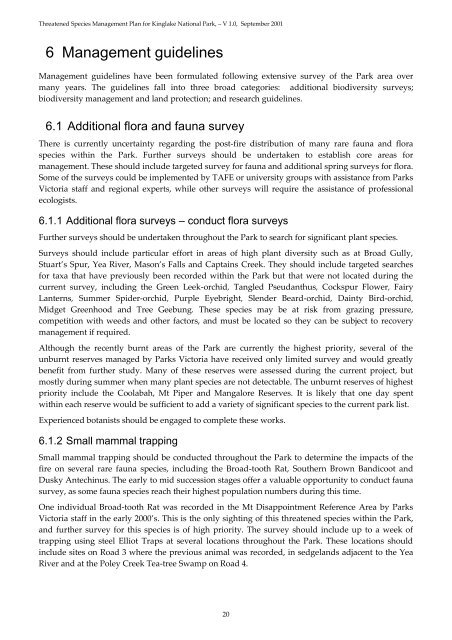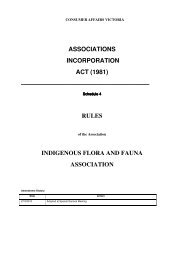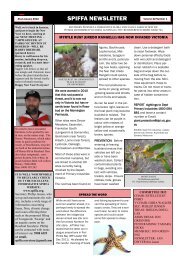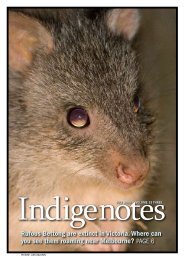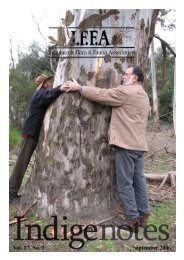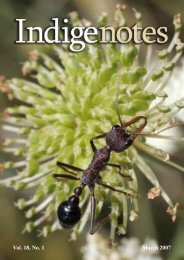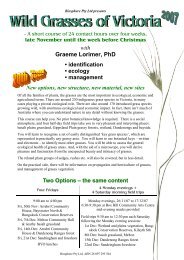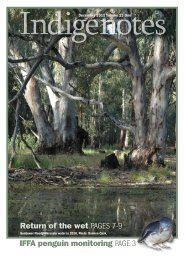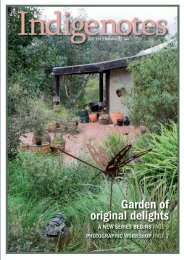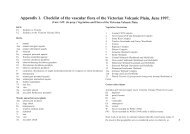Threatened Species Management Plan for Kinglake National Park
Threatened Species Management Plan for Kinglake National Park
Threatened Species Management Plan for Kinglake National Park
Create successful ePaper yourself
Turn your PDF publications into a flip-book with our unique Google optimized e-Paper software.
<strong>Threatened</strong> <strong>Species</strong> <strong>Management</strong> <strong>Plan</strong> <strong>for</strong> <strong>Kinglake</strong> <strong>National</strong> <strong>Park</strong>, – V 1.0, September 2001<br />
6 <strong>Management</strong> guidelines<br />
<strong>Management</strong> guidelines have been <strong>for</strong>mulated following extensive survey of the <strong>Park</strong> area over<br />
many years. The guidelines fall into three broad categories: additional biodiversity surveys;<br />
biodiversity management and land protection; and research guidelines.<br />
6.1 Additional flora and fauna survey<br />
There is currently uncertainty regarding the post-fire distribution of many rare fauna and flora<br />
species within the <strong>Park</strong>. Further surveys should be undertaken to establish core areas <strong>for</strong><br />
management. These should include targeted survey <strong>for</strong> fauna and additional spring surveys <strong>for</strong> flora.<br />
Some of the surveys could be implemented by TAFE or university groups with assistance from <strong>Park</strong>s<br />
Victoria staff and regional experts, while other surveys will require the assistance of professional<br />
ecologists.<br />
6.1.1 Additional flora surveys – conduct flora surveys<br />
Further surveys should be undertaken throughout the <strong>Park</strong> to search <strong>for</strong> significant plant species.<br />
Surveys should include particular ef<strong>for</strong>t in areas of high plant diversity such as at Broad Gully,<br />
Stuart’s Spur, Yea River, Mason’s Falls and Captains Creek. They should include targeted searches<br />
<strong>for</strong> taxa that have previously been recorded within the <strong>Park</strong> but that were not located during the<br />
current survey, including the Green Leek-orchid, Tangled Pseudanthus, Cockspur Flower, Fairy<br />
Lanterns, Summer Spider-orchid, Purple Eyebright, Slender Beard-orchid, Dainty Bird-orchid,<br />
Midget Greenhood and Tree Geebung. These species may be at risk from grazing pressure,<br />
competition with weeds and other factors, and must be located so they can be subject to recovery<br />
management if required.<br />
Although the recently burnt areas of the <strong>Park</strong> are currently the highest priority, several of the<br />
unburnt reserves managed by <strong>Park</strong>s Victoria have received only limited survey and would greatly<br />
benefit from further study. Many of these reserves were assessed during the current project, but<br />
mostly during summer when many plant species are not detectable. The unburnt reserves of highest<br />
priority include the Coolabah, Mt Piper and Mangalore Reserves. It is likely that one day spent<br />
within each reserve would be sufficient to add a variety of significant species to the current park list.<br />
Experienced botanists should be engaged to complete these works.<br />
6.1.2 Small mammal trapping<br />
Small mammal trapping should be conducted throughout the <strong>Park</strong> to determine the impacts of the<br />
fire on several rare fauna species, including the Broad-tooth Rat, Southern Brown Bandicoot and<br />
Dusky Antechinus. The early to mid succession stages offer a valuable opportunity to conduct fauna<br />
survey, as some fauna species reach their highest population numbers during this time.<br />
One individual Broad-tooth Rat was recorded in the Mt Disappointment Reference Area by <strong>Park</strong>s<br />
Victoria staff in the early 2000’s. This is the only sighting of this threatened species within the <strong>Park</strong>,<br />
and further survey <strong>for</strong> this species is of high priority. The survey should include up to a week of<br />
trapping using steel Elliot Traps at several locations throughout the <strong>Park</strong>. These locations should<br />
include sites on Road 3 where the previous animal was recorded, in sedgelands adjacent to the Yea<br />
River and at the Poley Creek Tea-tree Swamp on Road 4.<br />
20


